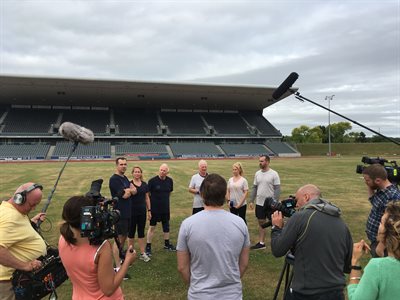 By: Paul Hough (Senior Lecturer - Health and Exercise Science)
By: Paul Hough (Senior Lecturer - Health and Exercise Science)
I recently contributed to a BBC television series called Twinstitute, hosted by Doctor and TV presenter twins Dr Chris and Dr Xand Van Tulleken. The series involved putting sets of identical twins through various experiments. One of these experiments involved testing the effectiveness of two completely different approaches to exercise:
Moderate vs. high intensity
It is well established that both exercise approaches improve health and fitness but, over the past decade, high intensity interval training (HIIT) has become an increasingly popular exercise strategy. Therefore, the producers wanted answer the question: is HIIT is better than the traditional, moderate intensity approach?
What is HIIT?
High intensity interval training (HIIT) involves brief bouts of high intensity (hard) exercise interspersed with short periods of light exercise or rest. There are numerous HIIT methods, which can broadly be categorised as 1. Sprint interval training (SIT) or 2. Aerobic interval training (AIT).
Sprint interval training (SIT)
SIT is characterised by supra-maximal (all-out) work periods lasting 10-30 seconds with long recovery periods of ≥5 times the duration of the work bout. When performing SIT there is no pacing – you simply go as hard as you can.
Aerobic interval training (AIT)
AIT typically involves work-bouts lasting 20 seconds to four minutes. This type of HIIT is not performed ‘all out’.Studies that have used AIT protocols have applied an intensity range corresponding to 80 – 170% of VO2max. In practice, this means the exercise is very hard, but not maximal. When using a rating of perceived exertion (RPE) scale, this corresponds to a rating of approximately 6-9 (0 = no effort, 10 = maximal effort).
The Twistitute experiment
The twins were mixed into two teams (moderate and HIIT) and I was asked to design a four-week exercise programme for each team to follow. I designed the exercise programmes based on the government physical activity guidelines, which state the recommended amount of physical activity for health benefits .
The Department of Health recommends three different strategies to achieve the physical activity guidelines:
- Perform at least 150 minutes (2½ hours) of moderate intensity activity (in bouts of 10 minutes or more). A common strategy is to perform 30 minutes physical activity 5 days/week.
- Research has also demonstrated that the same health benefits can be achieved with less time commitment, provided the activity is performed at a higher intensity(i.e. working harder). Therefore, performing 75 minutes of vigorous intensity activity (spread across the week) is an alternative to 150 minutes of moderate intensity activity.
- The final option is to perform combinations of moderate and vigorous intensity activity.
The training programmes
- The moderate (Xand’s) team adopted a moderate intensity (slow and steady) approach of 150 minutes of exercise per week. This consisted of walking, jogging, or any activity which elevated their heart rate to 64-76% of their maximum heart rate (HRmax).
- The high intensity (Chris’s) team performed 45 minutes of high intensity exercise/week. This was achieved by performing a HIIT* protocol at 77-95% of their HRmax. The remaining 30 minutes of exercise was performed at a moderate intensity, warming-up and cooling down. Therefore, the high intensity team did exactly half the weekly volume of exercise (75 minutes) compared to the moderate team.
Each twin wore a heart rate (HR) monitor when they were training to ensure they were exercising at the correct intensity. Monitoring HR during endurance exercise is a simple and accurate method to establish how hard you are working. In general, the higher the HR, the higher the exercise intensity.
*This was an aerobic interval training protocol (see HIIT definition above), meaning the twins were working hard, but not ‘all out’.
Guidelines on the HIIT training sessions performed during the programme are below. The participants in this experiment undertook a medical screening before participating in the exercise programmes. If you have not exercised for a while, it is a good idea to perform moderate intensity exercise for a few weeks before trying HIIT.
Fitness testing
The twins had their fitness measured before and after the four-week training programme. The test consisted of an incremental treadmill test to exhaustion, during which they were connected to a machine (metabolic cart), which measures physiological parameters, such as oxygen consumption and breathing rate.
The results
Maximal oxygen uptake (VO2max)
The women in the moderate and HIIT groups improved their VO2max. One of the HIIT twins experienced a 19% increase in VO2max, which is a huge improvement within 4 weeks. The VO2maxof the men did not change, which is likely due to their age (19 years older than the women). Unfortunately, as we age it becomes harder to improve VO2max. However, it is possible that their VO2maxmight have improved if we tested them after a few more weeks of training.
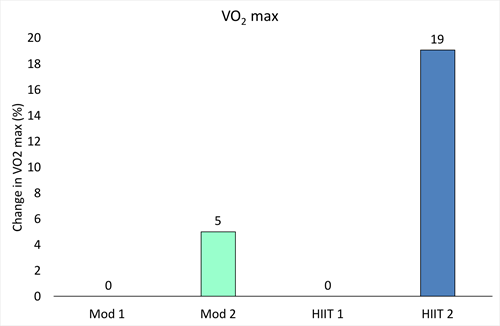
All the twins increased their ventilatory threshold (VT1), which is another maker of cardiorespiratory fitness.
Resting heart rate
Both teams experienced a reduction in resting HR after the training. However, the twins in the HIIT team demonstrated a greater reduction than the moderate team.
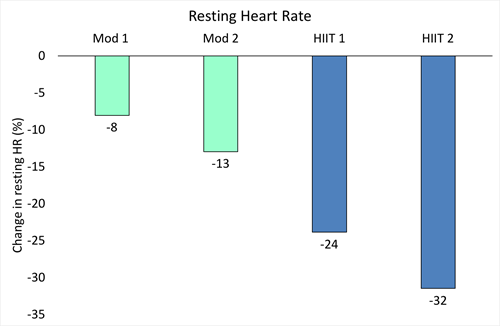
A lower resting HR is a marker of improved cardiovascular function, as a lower HR indicates an increase in stroke volume (amount of blood pumped by the heart) and vagal tone (impulses from the vagus nerve, which reduces HR).
Time to exhaustion (TTE)
Both teams were able to last longer on the exercise test after the training. However, as with the resting HR, the twins in the HIIT team demonstrated a greater improvement than the moderate team. Lasting longer on the exercise test is an indication of improved cardiorespiratory fitness and a greater tolerance to fatigue.
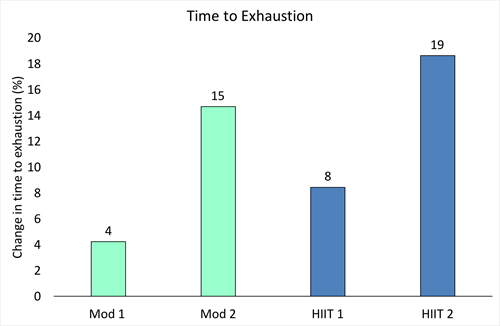
Conclusions
- The Twinstitute experiment demonstrated that both moderate and high intensity exercise can improve fitness in a short period (4 weeks).
- HIIT is a time efficient exercise method, as improvements in fitness can be achieved with a lower weekly time commitment (compared to moderate intensity exercise); this finding has been demonstrated in numerous studiesover the past 20 years.
- HIIT does not have to be performed ‘all out’ (100% effort) to improve fitness. A simple 1:1 (1 minute hard, 1 minute easy) protocol, such as the protocol used in the Twinstitute experiment, will be effective for most individuals.
Is HIIT better than moderate intensity exercise?
The shorter duration format of HIIT is attractive from an exercise promotion perspective, as a commonly cited barrier to engaging in regular exercise is ‘lack of time’. Therefore, if you are short on time, it would be better to perform HIIT instead of continuous, moderate intensity exercise, which takes longer. However, an exercise programme must be enjoyable in order to be continued in the long-term. Some people find HIIT more enjoyable than moderate-intensity (continuous) exercise. However, it is not clear if this enjoyment declines in the long-term. If you hate HIIT and prefer moderate intensity exercise, then moderate exercise is better for you. In other words, when it comes to selecting an exercise method, individual preference is key.
Experiment with different types of exercise until you find a type that you enjoy, as this will increase the likelihood of you sticking to the exercise on a long-term basis.
What if I don’t like exercising?
You might have noticed that the physical activity guidelines above do not mention ‘exercise’. The terms ‘exercise’ and ‘physical activity’ are used interchangeably, but they are not the same.Physical activity is, simply, any bodily movement that increases your energy expenditure. Therefore, provided you are physically active, it’s possible to improve your health/fitness without setting foot in a gym. There are many ways to achieve 150 minutes of physical activity/week by incorporating physical activity within your daily routine. For example:
- Monitor your daily step count with a fitness tracker or pedometer. Collecting quantifiable data will help you determine if you are making progress
- When possible, use stairs instead of escalators or elevators
- If using public transport, get off 1-2 stops early and walk to your destination
The HIIT episode of Twinstitute is available until 11thMarch 2019.
Find out more about our health and exercise science programme.
Twinstitute HIIT programme
Warm-up
Perform a 5 minute warm-up before each training session. You should feel warm, breathing heavily and have started to sweat by the end of the 5 minute warm-up.
Intervals
- The intensity during the intervals should be hard, but you do not need to go ‘all out’ as fast as possible.
- On a scale of 0-10 (0 = rest, 10 = all-out effort), you should aim to be between 6-8.
- If you are using a HR monitor, it might take 2 intervals before you are in the target HR zone. Your HR may exceed the zone at some point.
- After week 1, perform an additional (1 hard) interval during each session (i.e. 8 intervals in total)
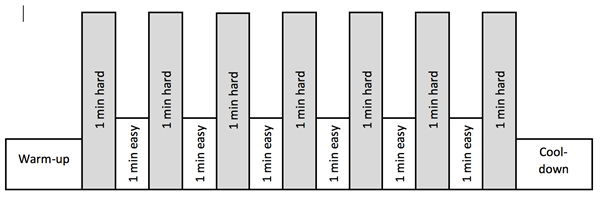
Cool down
- Perform a 5 minute cool-down of light cycling/walking at after the final interval. You can extend this by 2-3 minutes if you wish.